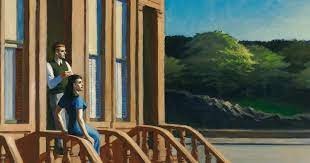James Panero in New Criterion:
 Edward Hopper (1882–1967) was the painter of small-town America. This we know. That his small town happened to be New York City, his home for nearly sixty years, we may not know. “Edward Hopper’s New York,” now on view at the Whitney Museum of American Art, tells the hometown story of an artist we thought we knew all along in a novel and illuminating way.1
Edward Hopper (1882–1967) was the painter of small-town America. This we know. That his small town happened to be New York City, his home for nearly sixty years, we may not know. “Edward Hopper’s New York,” now on view at the Whitney Museum of American Art, tells the hometown story of an artist we thought we knew all along in a novel and illuminating way.1
It is certainly an achievement when an exhibition of a famous artist is able to surprise. When such an exhibition can also instruct and delight—and do so without resorting to the clichés of contemporary theory—this is a rare triumph. And when the subject is a dead white male painter—a conservative, anti–New Deal Republican, no less, who rejected every school and trend to look to the loneliness of the human condition—here is a show that must be seen to be believed. “Edward Hopper’s New York” is such an exhibition and will open many eyes to this artist’s elegiac vision.
More here.
